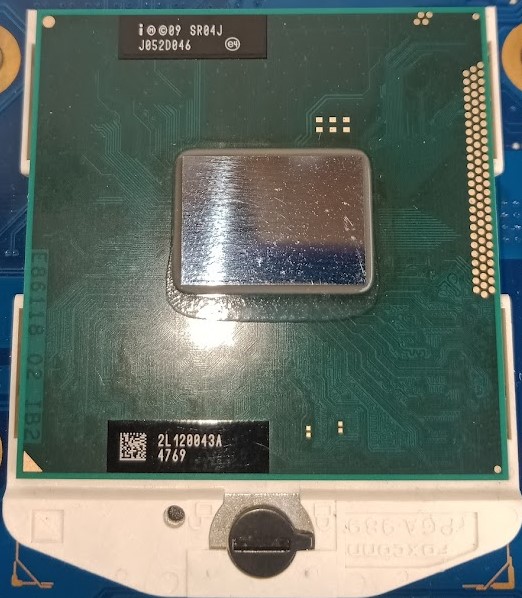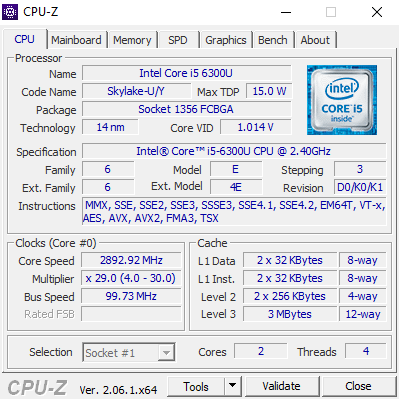Comparing: Intel Core i3 2330M vs Intel Core i5 6300U
In this comparison, we analyze two Processors: Intel Core i3 2330M and Intel Core i5 6300U, using synthetic benchmark tests to evaluate their overall performance. This side-by-side comparison helps users understand which hardware delivers better value, speed, and efficiency based on standardized testing. Whether you're building a new system or upgrading an existing one, this benchmark-driven evaluation offers valuable insights to guide your decision.
Specification Comparison Table
This specification comparison presents technical details of several devices or components to help you understand the key differences between each option. Use this table as a reference to determine which device best suits your needs.
| Specification | Intel Core i3 2330M | Intel Core i5 6300U |
|---|---|---|
| Architecture | x86 | x86 |
| Technology | 32 nm | 14 nm |
| Clock | 2.2 GHz - - | 2.4 GHz - 3 GHz |
| Core/Thread | 2 / 4 | 2 / 4 |
| Segmen | Mobile | Mobile |
Submission Comparison Table
This submission comparison table displays the number and details of benchmark data submissions from various devices or components. This information helps you understand the performance based on the benchmarks that have been tested, as well as providing an overview of the consistency and popularity of the available benchmark results.
| No. | Benchmark Software | Intel Core i3 2330M | Intel Core i5 6300U |
|---|---|---|---|
| 1 | Cinebench - 2003 |
1067 cb |
1601 cb |
| 2 | Cinebench - R11.5 |
1.95 pts |
2.91 pts |
| 3 | Cinebench - R15 |
163 cb |
262 cb |
| 4 | Cinebench - R20 |
413 pts |
656 pts |
| 5 | Geekbench3 - Multi Core |
3652 points |
5290 points |
| 6 | Geekbench3 - Single Core |
1718 points |
2561 points |
| 7 | Geekbench4 - Multi Core |
4322 points |
6112 points |
| 8 | Geekbench4 - Single Core |
2239 points |
3309 points |
| 9 | Geekbench5 - Multi Core |
936 points |
1397 points |
| 10 | Geekbench5 - Single Core |
410 points |
711 points |
| 11 | PiFast |
34sec, 710ms |
23sec, 10ms |
| 12 | SuperPi - 1M |
18sec, 143ms |
12sec, 607ms |
| 13 | SuperPi - 32M |
16min, 54sec, 925ms |
10min, 50sec, 377ms |
| 14 | wPrime - 32M |
23sec, 73ms |
15sec, 976ms |
| 15 | wPrime - 1024M |
11min, 51sec, 960ms |
8min, 37sec, 272ms |
Submission Comparison Chart
This chart visualizes the benchmark scores comparison between two hardware devices based on submitted data.
Media Gallery
A collection of photos of tested hardware. These images can help you identify the physical form, model, and variant of the hardware in question. These photos are from our own documentation, and if they are not available we may not be able to document them.
About Hardware Intel Core i3 2330M
The Intel Core i3-2330M is a dual-core mobile processor launched in 2011 as part of Intel’s second-generation Sandy Bridge lineup. Designed for mid-range laptops, this processor features 2 cores and 4 threads thanks to Intel Hyper-Threading Technology, allowing it to handle light to moderate multitasking workloads efficiently. Operating at a fixed clock speed of 2.2 GHz and built on the 32nm process, the i3-2330M does not include Intel Turbo Boost, which limits its ability to dynamically increase performance under heavier loads, but it remains a solid choice for everyday use.
With a TDP of 35W, the i3-2330M balances power consumption and performance reasonably well for its era. It integrates Intel HD Graphics 3000, a GPU with a base clock of 650 MHz and a dynamic frequency up to 1.1 GHz. While not designed for modern gaming or demanding graphic applications, this integrated GPU handles HD video playback, basic 3D rendering, and older or lightweight games at low settings with relative ease. Users looking for casual computing and multimedia playback will find it sufficient.
In real-world usage, the Core i3-2330M performs well for standard computing tasks such as web browsing, streaming, office productivity (e.g., Word, Excel), and simple photo editing. Its Hyper-Threading capabilities give it a performance edge over older dual-core processors that lack thread duplication. However, the lack of Turbo Boost and a relatively low base frequency mean that it can struggle under CPU-intensive workloads like video rendering or large spreadsheet processing, especially when compared to more modern CPUs.
This specific configuration was tested on a SAMSUNG 300E4Z, a laptop originally shipped with an Intel Celeron B815 processor but later upgraded to the i3-2330M for better performance. With 4GB of DDR3 dual-channel memory and Windows 7 installed, the system runs smoothly for basic daily use, making the i3-2330M a practical upgrade option for budget-conscious users seeking improved performance without replacing their entire system.
Hardware Detail:
Device: SAMSUNG 300E4Z (This device originally used Celeron B815 which was upgraded to i3 2330M.)
RAM: 4GB DDR3 Dual Channel
OS: Windows 7
Friday, 05 February 2021 15:48:13 | Update: 1 month ago
About Hardware Intel Core i5 6300U
The Intel Core i5-6300U is a dual-core, quad-thread mobile processor that belongs to Intel’s Skylake generation, released in 2015. Designed with power efficiency in mind, the i5-6300U operates at a base clock speed of 2.4 GHz and can dynamically boost up to 3.0 GHz thanks to Intel’s Turbo Boost technology. Built on a 14nm manufacturing process, this processor has a low thermal design power (TDP) of just 15 watts, making it ideal for ultrabooks and slim laptops where battery life and heat management are crucial. The chip features integrated Intel HD Graphics 520, which supports smooth 4K video playback and can handle light gaming and everyday graphical tasks, making it suitable for casual multimedia users.
In practical use, the i5-6300U offers reliable performance for common activities such as web browsing, office productivity software, video streaming, and basic photo editing. It is commonly found in business laptops like the Lenovo ThinkPad T470, equipped with 8GB DDR4 RAM and running Windows 10, providing a smooth user experience for professionals and students alike. Despite its strengths, the i5-6300U’s performance in modern multi-threaded applications and gaming falls behind newer processors due to its limited cores and older architecture. Nevertheless, it remains a solid choice for users prioritizing energy efficiency and portability over raw computing power.
Overall, the Intel Core i5-6300U continues to be a dependable processor in the used laptop market and legacy systems, delivering a good balance of performance and power consumption for everyday computing tasks, especially in ultrabook designs where efficiency is key.
Hardware Detail:
Device: Lenovo ThinkPad T470
RAM: 8GB DDR4 Single Channel
OS: Windows 10
Thursday, 10 August 2023 10:15:48 | Update: 1 month ago





